#construction owner's representative
Explore tagged Tumblr posts
Text

Project Management Consultancy Services | Adaptive
Looking for top-notch Project Management Consultancy Services? Look no further than Adaptive! Our experienced team offers tailored solutions to streamline your projects, from planning to execution. With a focus on efficiency and quality, we ensure timely delivery and cost-effective outcomes. Trust Adaptive for expert guidance, comprehensive project oversight, and successful results every time.
1 note
·
View note
Text
Why Should Hospitality Real Estate Developers Use a Development Owner’s Representative?
For hospitality real estate developers, leveraging a Development Owners Representative can significantly enhance project outcomes. These representatives act as an extension of real estate development companies , providing expertise and oversight from project inception to completion. By ensuring that every aspect of the development aligns with the developer's vision and goals, they help mitigate risks and streamline the construction process.
A Development Owner’s Representative brings invaluable insights into Commercial real estate construction management. They coordinate between various stakeholders, handle complex logistics, and ensure that projects adhere to budgets and timelines. This comprehensive management approach is particularly beneficial in the hospitality sector, where the integration of design, functionality, and guest experience is crucial.
For real estate development companies, partnering with a Development Owner’s Representative means having a dedicated advocate who prioritizes their interests. This collaboration fosters more efficient communication, better problem-solving, and ultimately, more successful project completions.
Explore the detailed benefits and real-world examples of how a Development Owner’s Representative can elevate your next hospitality project in our latest blog post here.
#"Real estate development companies#Development Owner’s Representative#commercial real estate construction management#hospitality real estate developers
0 notes
Text
Owner Representative
#Owner Representative#top project management firm in nyc#contruction#project management#construction management#construction management services
0 notes
Text
What does an Owner's Agent do in Construction Management of Project?
Hiring an Owner's Agent is helpful in the Construction Management. He will add value to the entire process and complete your project within the deadline without facing significant challenges. You will have your dream project ready on time.
#Owner's Agent for Construction Management#owner's representative for construction projects#owner's representative#Managing Design#General Contracting teams#land development project#general contracting
0 notes
Text
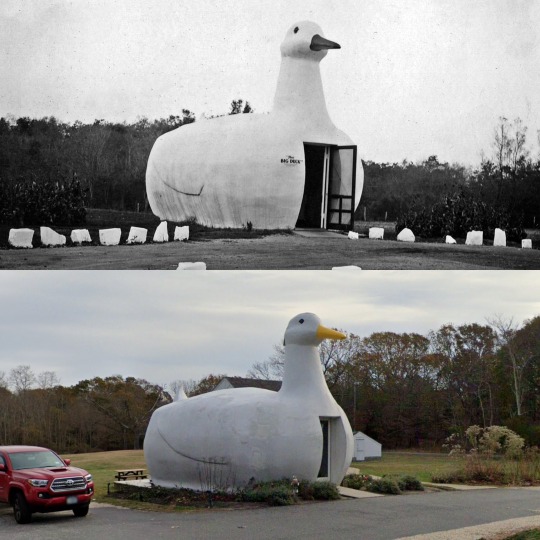



Do you know why Novelty or Memetic Architecture is sometimes called Duck Architecture?
It’s because of this duck in New York.
Long Island’s Big Duck was built in 1931 by a duck farmer who sold ducks, eggs and milk. While the Duck’s owner and location changed multiple times, it continued to operate as a shop until the 1980s and was added to the National Register of Historic Places in 1997.
Duck Architecture became a term used to describe buildings that are “sculptural in form and explicitly represent their function through their shape and construction.” So because the duck shaped building sold ducks, it’s duck architecture. If a teapot shaped building sold tea, it’s duck architecture. If a whale shaped building sold whales, it’s duck architecture. Get it?
Today, the Big Duck is no longer privately owned and remains a popular tourist attraction. The county maintains the interior while the town maintains the exterior.
570 notes
·
View notes
Text
Why we don’t like it when children hit us back
To all the children who have ever been told to “respect” someone that hated them.
March 21, 2023
Even those of us that are disturbed by the thought of how widespread corporal punishment still is in all ranks of society are uncomfortable at the idea of a child defending themself using violence against their oppressors and abusers. A child who hits back proves that the adults “were right all along,” that their violence was justified. Even as they would cheer an adult victim for defending themself fiercely.
Even those “child rights advocates” imagine the right child victim as one who takes it without ever stopping to love “its” owners. Tear-stained and afraid, the child is too innocent to be hit in a guilt-free manner. No one likes to imagine the Brat as Victim—the child who does, according to adultist logic, deserve being hit, because they follow their desires, because they walk the world with their head high, because they talk back, because they are loud, because they are unapologetically here, and resistant to being cast in the role of guest of a world that is just not made for them.
If we are against corporal punishment, the brat is our gotcha, the proof that it is actually not that much of an injustice. The brat unsettles us, so much that the “bad seed” is a stock character in horror, a genre that is much permeated by the adult gaze (defined as “the way children are viewed, represented and portrayed by adults; and finally society’s conception of children and the way this is perpetuated within institutions, and inherent in all interactions with children”), where the adult fear for the subversion of the structures that keep children under control is very much represented.
It might be very well true that the Brat has something unnatural and sinister about them in this world, as they are at constant war with everything that has ever been created, since everything that has been created has been built with the purpose of subjugating them. This is why it feels unnatural to watch a child hitting back instead of cowering. We feel like it’s not right. We feel like history is staring back at us, and all the horror we felt at any rebel and wayward child who has ever lived, we are feeling right now for that reject of the construct of “childhood innocence.” The child who hits back is at such clash with our construction of childhood because we defined violence in all of its forms as the province of the adult, especially the adult in authority.
The adult has an explicit sanction by the state to do violence to the child, while the child has both a social and legal prohibition to even think of defending themself with their fists. Legislation such as “parent-child tort immunity” makes this clear. The adult’s designed place is as the one who hits, and has a right and even an encouragement to do so, the one who acts, as the person. The child’s designed place is as the one who gets hit, and has an obligation to accept that, as the one who suffers acts, as the object. When a child forcibly breaks out of their place, they are reversing the supposed “natural order” in a radical way.
This is why, for the youth liberationist, there should be nothing more beautiful to witness that the child who snaps. We have an unique horror for parricide, and a terrible indifference at the 450 children murdered every year by their parents in just the USA, without even mentioning all the indirect suicides caused by parental abuse. As a Psychology Today article about so-called “parricide” puts it:
Unlike adults who kill their parents, teenagers become parricide offenders when conditions in the home are intolerable but their alternatives are limited. Unlike adults, kids cannot simply leave. The law has made it a crime for young people to run away. Juveniles who commit parricide usually do consider running away, but many do not know any place where they can seek refuge. Those who do run are generally picked up and returned home, or go back on their own: Surviving on the streets is hardly a realistic alternative for youths with meager financial resources, limited education, and few skills.
By far, the severely abused child is the most frequently encountered type of offender. According to Paul Mones, a Los Angeles attorney who specializes in defending adolescent parricide offenders, more than 90 percent have been abused by their parents. In-depth portraits of such youths have frequently shown that they killed because they could no longer tolerate conditions at home. These children were psychologically abused by one or both parents and often suffered physical, sexual, and verbal abuse as well—and witnessed it given to others in the household. They did not typically have histories of severe mental illness or of serious and extensive delinquent behavior. They were not criminally sophisticated. For them, the killings represented an act of desperation—the only way out of a family situation they could no longer endure.
- Heide, Why Kids Kill Parents, 1992.
Despite these being the most frequent conditions of “parricide,” it still brings unique disgust to think about it for most people. The sympathy extended to murdering parents is never extended even to the most desperate child, who chose to kill to not be killed. They chose to stop enduring silently, and that was their greatest crime; that is the crime of the child who hits back. Hell, children aren’t even supposed to talk back. They are not supposed to be anything but grateful for the miserable pieces of space that adults carve out in a world hostile to children for them to live following adult rules. It isn’t rare for children to notice the adult monopoly on violence and force when they interact with figures like teachers, and the way they use words like “respect.” In fact, this social dynamic has been noticed quite often:
Sometimes people use “respect” to mean “treating someone like a person” and sometimes they use “respect” to mean “treating someone like an authority” and sometimes people who are used to being treated like an authority say “if you won’t respect me I won’t respect you” and they mean “if you won’t treat me like an authority I won’t treat you like a person” and they think they’re being fair but they aren’t, and it’s not okay.
(https://soycrates.tumblr.com/post/115633137923/stimmyabby-sometimes-people-use-respect-to-mean)
But it has received almost no condemnation in the public eye. No voices have raised to contrast the adult monopoly on violence towards child bodies and child minds. No voices have raised to praise the child who hits back. Because they do deserve praise. Because the child who sets their foot down and says this belongs to me, even when it’s something like their own body that they are claiming, is committing one of the most serious crimes against adult society, who wants them dispossessed.
Sources:
“The Adult Gaze: a tool of control and oppression,” https://livingwithoutschool.com/2021/07/29/the-adult-gaze-a-tool-of-control-and-oppression
“Filicide,” https://en.wikipedia.org/wiki/Filicide
#repost of someone else’s content#medium repost#Alba M.#purity culture#ageism#adultism#youth oppression#childism#child abuse#parental abuse#youth rights#youthlib#youth liberation#parricide#nuclear family abolition#anarchism#note: I would consider reevaluating the demonization of adults who kill their parents too#many victims remain entrapped well into adulthood#there are still a lot of issues of economic dependency and control especially for young adults#and I don’t think such a totalizing power imbalance engendered in childhood is so easily levelled#even if an adult does become financially independent#likewise for adult victims of intimate partner abuse: also structurally made difficult for them to leave#even if not criminalized to the same degree#anti-abuser aktion
3K notes
·
View notes
Text
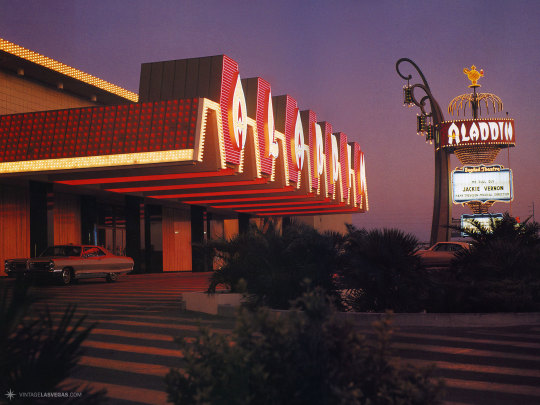
Tally Ho / Aladdin / Planet Hollywood
Aladdin opened in 1966 with one of the Strip's first neon-enhanced porte-cochéres, a freestanding sign featuring a revolving, three-sided marquee, topped with an "Aladdin's Lamp," designed and fabricated by YESCO.
Tally Ho ('62-'65)
'61: Edwin S. Lowe announces plans for Tally Ho non-gaming hotel. In the 40s the land was owned by locals Salton, Rose, and Goldberg. (Alexander & Rebecca Salton, founding members of the Las Vegas Jewish community.)
'62: Dec. 24, Opening of Tally-Ho, hotel and country club with 9-hole golf course. 322 of the 450 rooms open during “preview opening” in Dec. The hotel was alternately spelled Tally Ho, Tally-Ho, and Tallyho.
'63: Oct. 11, Tally Ho closed. “Ed Lowe made no excuses … admits he was dead wrong about a no gambling luxury hotel.” (Hertz, RJ 10/13/63)
'63: Oct., Norman Kaye and Frank Windsor operate the Tally Ho golf course.
'63: Oct.-Dec., The hotel is sold to Kings Crown Inns of America, represented by Floyd and Beryl Cook, Donald Bolinger (Cooks Brothers Trusts, Indiana). Under lease to operators Edward Nealis, Charles Luftig, and partners, Kings Crown Tally Ho's hotel, lounge, and restaurants reopen in Dec. (Duke, RJ 12/20/63)
'64: Construction of a showroom and casino begins in Fall, misses New Year's Eve opening deadline. The showroom and casino are completed in '65, ultimately never opened. (RJ 4/8/64, RJ 5/18/65)
'65: Nealis heads 18 casino applicants of Tallyho Operating Co. who are unable to get approval from Nevada Gaming Control Board (GCB). In later years Jimmy "the Weasel" Fratianno of the Los Angeles crime family claimed he owned a piece of the Tally Ho and was to run the casino. (AP 2/17/65, RJ 11/25/84, Mob Museum 12/8/2017)
'65: Apr. 1, Tally Ho closed for the second time after King's Crown files suit against Tallyho Operating Co. for unpaid rent. Tenants are evicted, property put in control of the owners.
'65: Dec., Tally Ho bought by Milton Prell (Prell Hotel Corp.) from The Cooks Brothers Trusts.
Aladdin ('66-'97)
'66: Aladdin announced. Drawings for redesigned casino and proposed hotel tower unveiled early in the year. Martin Stern, architect. (RJ 1/2/66, RJ 1/17/66)
'66: Mar. 31, Aladdin opened. Freestanding sign and the Strip's first neon-enhanced porte-cochère by YESCO. Primary owners M. Prell, G. Gilbert, and S. Krystal, all former members of Sahara-Nevada Corp. Comedian Jackie Mason opens the 500-seat Baghdad Theatre.
'66: Dec., Prell stops $75k/month payments on the Aladdin and asks that the price be cut. The trustees agree to reduce the sale price to $5.5M. (Dayton, 4/20/72)
'67: Sep. 26, Milton Prell suffers a debilitating stroke which removes him from Aladdin management. (Dayton, 4/20/72)
'68: Apr., Stockholders of Prell Hotel Corp. vote to merge with Parvin-Dohrmann Co., leading to Parvin-Dohrmann take-over the Aladdin.
'68: Jun., Parvin-Dohrmann operation of Aladdin’s casino approved by GCB. (RJ 6/20/68)
'68: Sep., 28, "after the stock trade was finalized, Milton Prell, by this time paralyzed, was told by the new management he had two weeks to get out of the Aladdin." (McKnight, Alexander. Journal Herald, 4/20/72)
'70: Parvin-Dohrmann adopts the new name Recrion, and strips the firm of all its holdings except for its three Las Vegas hotel-casinos: Aladdin, Fremont, and Stardust.
'71: Oct.-Dec., Recrion announces sale to Sam Diamond, P. Webbe, R. Daly, D. Aikin as Aladdin Hotel Corp. Diamond announces plans for hotel tower.
'71: Entertainment director James Tamer is involved in secretly managing the casino and directing the skim, according to later conviction.
'74: Aladdin investigated by GCB for issuing comps to organized crime figures.
'74: Groundbreaking for the “Tower of Majesty” high-rise, and theater. Lee Linton, architect. Years later in '83, Linton and Aladdin attorney Sorkis Webbe are each convicted of tax fraud in relating to a kickback scheme during the '74 expansion.
'76: Jul., Tower and Theatre for the Performing Arts opened; new porte-cochère by Charles Barnard, Ad-Art; original sign replaced; all financed by Teamsters Central States Pension Fund loan.
'76: Mae Ellen George buys 24% of the hotel, relying on advice of Tamer.
'78: Aug. 3, Detroit federal grand jury indicts Tamer, Aladdin GM James Abraham, Aladdin casino manager Edward Monazym, and Charles Goldfarb (denied a license in ’71) of conspiring to allow hidden owners to exert control over the resort. Owners of the Aladdin at this time are Webbe (34%), Diamond (23%), Mae George (19%), Daly (14%), John Jenkins (8%), and George Morse (2%). (RJ 8/3/78)
'79: Mar. 13, Tamer, Abraham, Monazym, and Goldfarb convicted.
'79: Aug., GCB closes the resort; U.S. District Judge Claiborne opens it hours later, “until a mob-free buyer could be found.” (German, RJ 9/20/2021.)
'80: Jan., Ed Nigro gains a court-sanctioned takeover of the Aladdin after he and Johnny Carson sign an agreement to buy the property for $105M. The deal falls through.
'80: Jul. 10, GCB revokes Aladdin's license and the casino is closed; hotel remains open.
'80: Oct. 1, Casino is reopened after Ed Torres and Wayne Newton buy the Aladdin for $85M.
'82: Jul, Torres buys Newton's shares of the Aladdin.
'84: Feb., Aladdin placed under bankruptcy protection after a Teamsters Pension Fund forces foreclosure.
'85: Jan. 22, Ginji Yasuda buys the Aladdin for $54M; casino closed during Yasuda licensing.
'87: Apr. 1, gaming reopens.
'89: Aug., Yasuda, failing to reveal the source of millions in loans, loses his gaming license; Aladdin forced into bankruptcy.
'89: Sep., Court appointed trustee Jack Fidelman, and WDT Associates (Wm. and Tim Dougall, Larry Bertsch) take over operating the hotel. Aladdin remains in bankruptcy through the early 90s.
'91: Jun., Property title transferred to Bell Atlantic Tricon Leasing Corp when no buyers meet the minimum bid.
'92: Jun., Aladdin emerges from 3-year bankruptcy, control is given to Joe Burt and his JMJ management team on a 12-year lease with Bell Atlantic Tricon.
'94: Dec., Jack Sommer, Signman Sommer Family Trust, buys the Aladdin for $80M. "When the family trust sold a major New York property in '94, Sommer needed to find a real estate investment for the proceeds to avoid substantial capital-gains taxes. The Aladdin was on the market at the time." (Simpson. RJ 8/13/2000.) Other potential buyers included Donald Trump.
'97, Nov 25: Aladdin closed. A new hotel-casino to be built on the 35-acre parcel.
'98, Apr 28: Aladdin tower demolished. Former Tally Ho rooms later demolished; Theater remains.
Aladdin (2000-2007) Planet Hollywood (2007-)
2000: New build of the Aladdin. Mall opens 8/17/00, hotel and casino delayed, opening 8/18/00. Cost: $1.1B.
2001: Sep., Aladdin files for bankruptcy.
2003: Aladdin sold for $635M to OpBiz investment group led by Planet Hollywood CEO Robert Earl. Sale finalized 9/1/2004.
2007: Apr. 17, renamed Planet Hollywood.
2009: Harrah’s Ent. purchases part of the $860M mortgage, takes full ownership in Feb. 2010. Harrah’s later rebranded as Caesars Entertainment.
Photos of Tally Ho | Photos of the Aladdin
Headline photo: Undated, circa '68, from The Magic Sign by Charles Barnard.

Circa Feb.-Mar. 1966: The hotel was open before the casino. Installation of the sign is beginning. Photo: Las Vegas News Bureau.




Mar. 1966: Sequence of photographs showing YESCO’s revolving, three-sided Aladdin pylon structure being pieced together by dual cranes ahead of their opening on the 31st. Ad-Art collection, from Charles Barnard’s The Magic Sign.

Undated, Las Vegas News Bureau.
Timeline sources. Previous landowners: C.D. Baker Map of Las Vegas Valley ’40; Alexander Salton. UNLV Special Collections & Archives.
Tally Ho: Tallyho Preview Attracts 3500. Review-Journal, 12/28/62; Tallyho Hotel Closes. Review-Journal, 10/11/63 p1; Murray Hertz. Future of Tallyho Raises Questions. Review-Journal, 10/13/63; Gordon Kent. Tally-Ho Hotel Sold. Review-Journal, 11/1/63; Forrest Duke. New Tallyho Sale Deal. Review-Journal, 12/20/63; Tallyho Plans $1 Million Show. Review-Journal, 4/8/64; Associated Press. Gaming Board Refuses Tallyho Casino License. Review-Journal, 2/17/65 p1; G. Kent, F. Duke. Strip Hotel Closes. Review-Journal, 4/1/65 p1; Tallyho Sues Owners. Review-Journal, 5/18/65 p1.
Tally Ho and Aladdin sales covered in a series by Keith McKnight and Andrew Alexander for The Journal Herald, Dayton OH. Welsh confirmed with crime figures. Journal Herald, 4/20/72; Firm with crime ties linked to casino deal. Journal Herald, 4/21/72.
Aladdin: Associated Press. Gamers Approve. Review-Journal, 6/20/68 p1; Associated Press. Firm adopts new name: Recrion Corp. Reno Gazette Journal, 12/14/70; Lou Miller. Aladdin Hotel sold. Review-Journal, 11/8/71; Jerry Ralya. New Aladdin Corporation seeks license. Review-Journal, 12/29/71; Aladdin execs indicted. Review-Journal, 8/3/78; AP. Las Vegas architect sentenced to prison. Review-Journal, 3/8/83; AP. Webbe convicted. Review-Journal, 6/19/83; Jane Ann Morrison. LV Casinos Targeted in Money Laundering. Review-Journal, 11/25/84; Aladdin Hotel's history spans 30 years. Review-Journal, 1/5/94 p3; Dave Palermo. Aladdin Hotel finally sells. Review-Journal, 12/9/94 p1; History. Review-Journal, 11/23/97 p14; Jeff Simpson. Aladdin owner faces music. Review-Journal, 8/13/2000; Chronology of the Aladdin hotel-casino. Las Vegas Sun, 8/18/2000. John L. Smith. Sharks in the Desert. Barricade Books, 2005; David Schwartz. Jimmy The Weasel Fratianno. themobmuseum.org, 12/8/2017; Jeff German. The Genie in the Lamp, and Close the Place Down. Review-Journal, 9/20/2021.
90 notes
·
View notes
Text

Today, we have a bunker for sale. It's not as interesting as a decommissioned missile tower. "Originally constructed in the 1960s at a cost of $4.5 million, an equivalent value today exceeding $34 million, this bunker represents the pinnacle of security and resilience." Located in Polo, Missouri, 35 min. from Kansas City, it has 4bds, 2ba, $2M.

The entrance hall has an industrial look, but they tired to make the home look elegant.

It has 2 massive 3,000 pound blast doors, 2.5-foot-thick concrete walls, additional layers of earth & EMP-resistant copper shielding, plus an emergency escape hatch and a towering 177-ft communication tower.

it's roomy- look at the size of the living room. One must wonder why people decorate these with traditional furniture. It needs colorful, modern stuff.


There's a bar for entertaining.

One of the bathrooms.

This is a soundproof room- it's not as if there are any neighbors around, though.

They have a home office here.


Laundry and stuff. The self-sufficient home has a private water well, a pump, and a 10,000-gallon stainless steel water storage tank, all connected to a Water Filtration System.

And, here's your new hobby- it's a glass blowing studio. I wonder if the owner would teach the new owner how to use it.

Looks like a massive air system.

Above the workshop is a large loft area.
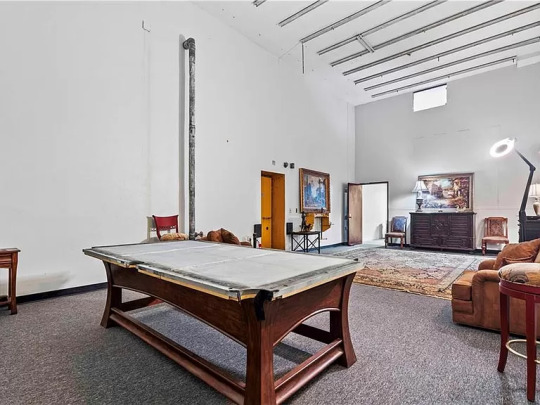

There's a family room- notice the windows above, they are for some of the bedrooms. There's also supposed to be a home theater room, but it's not shown.

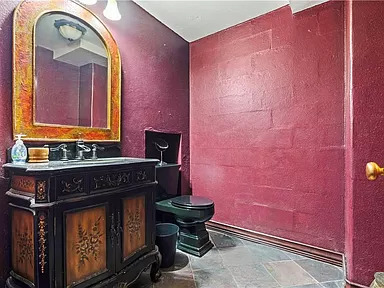
On the 2nd fl. is the 2nd bath. Not liking the hole in the wall behind the toilet.

This is the kitchen.
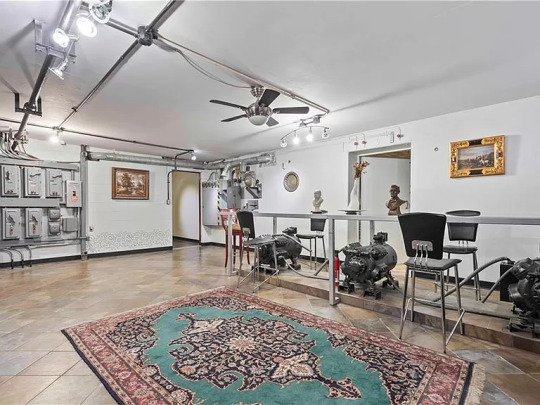

This is an odd place to locate the kitchen w/all this other equipment.

Through the kitchen you can see the upstairs living room.

You can see that the kitchen is on the other side.


The bedrooms are off a hall off of the living room.



The bedrooms.
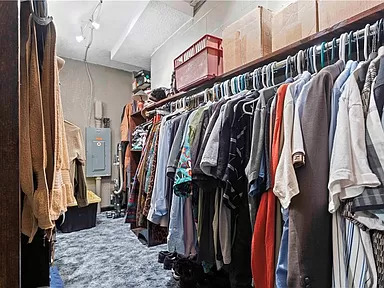
This area serves as a closet.

The plot of land is 10.5 acres and the real estate description suggests that you can built your dream home on it, over the bunker.
224 notes
·
View notes
Text

Tarot Cards as Professions

Navigation: Masterlist✦Ask Rules✦Feedback Tips
Askbox✦Sources✦Paid Readings

Major Arcanas:
The Fool: Work with abroad, connections with imports, language teacher, multinationals, entrepreneur, intern, college student, art major.
The Magician: Entrepreneur, job that needs skill with the hands (acupuncture, hairdresser, artisan), actor, salesperson, influencer.
The High Priestess: Education, especially children, nutrition, psychology, cook, housewife, food engineering, toy factory, fortuneteller, spiritual advisor, librarian.
The Empress: Management, business administration, foreign trade, secretariat, translation, decoration, stay-at-home mom, model, cook, farmer.
The Emperor: Business administration, work related to areas of technological innovation, the military or sportsmen, CEO, tycoon.
The Hierophant: Philanthropic areas, ONGs, religious work, social work, diplomacy, and a degree, journalism, writer, editor, priest, spiritual guru, politician.
The Lovers: Sales area in any sector, tourism, theater, advertising, the arts in general, porn star, stripper, masseuse.
The Chariot: Activities related to transport, cars, the latest technology, chauffeur, mechanic, athlete.
Strength: Aesthetics, physical education and various body therapies, medicine, zoologist.
The Hermit: Teacher, writer, doctor, antique dealer, restorer, librarian, gardener.
Wheel of Fortune: Financial market, exchange offices, casinos, lottery houses, stock exchanges, and areas related to public relations, hospitality, game show host.
Justice: Public jobs, won through competitions, politics, police, with government positions, in the diplomatic area, law, insurance company worker.
The Hanged Man: Nurse, auditor, inspector, porter, secretariat, general assistants, yoga instructor, prison guard, philanthropist.
Death: Doctor, farmer, geologist, business administrator, gardener, accountant, assassin, death row executioner, surgeon.
Temperance: Working with liquids in general or with what is transported in liquid form such as alcoholic beverages, medicines, juices. chemist, chef, food critic, regional or even international traffic.
The Devil: Does not limit the individual to a professional wing, so he can also go to extremes for the desire he has, such as landlord, drug lord, sex trafficker.
The Tower: Social assistance, humanitarian aid, medicine, firefighter, police officer, construction worker.
The Star: Music, painting, sculpture, poetry, cinema, makeup artist, dressmaker, beautician, agent, promoter, sound artist, astronomer, harpist, dealer, meteorologist.
The Moon: Oceanographers, sailors, fishermen, owners of bars and restaurants or nightclubs, artists in general, medium, hypnotist, psychiatrist.
The Sun: Motivational speaker, entertainer, comedian, social relationships, work with the public, artist in general, member of society.
Judgment: Work done at home, connection with the law, lawyer, judge, work with disabled or people excluded from society, social assistance, board member, executive producer, director.
The World: Pharmacist, massage therapist, scientist, teacher, community leader, religious leader or priest, fashion designer, makeup artist, interior decorator.

Wands:
Creative industries such as advertising, marketing, and graphic design.
Entrepreneurship and starting your own business.
Athletics, sports coaching, or physical training.
Outdoor jobs like park ranger or tour guide.
Event planning or organizing.
Firefighters or rescue workers.
Ace of Wands: Entrepreneur, startup founder, motivational speaker, fitness coach, personal trainer.
Two of Wands: Business strategist, project manager, travel agent, international consultant, import/export specialist.
Three of Wands: Sales representative, marketing manager, e-commerce entrepreneur, market researcher, international trade coordinator.
Four of Wands: Event planner, wedding coordinator, party organizer, festival manager, hospitality industry professional.
Five of Wands: Conflict resolution specialist, mediator, lawyer, debate coach, competitive sports coach.
Six of Wands: Public relations manager, spokesperson, social media influencer, motivational speaker, winning athlete.
Seven of Wands: Defense attorney, human rights activist, political campaigner, advocate, civil liberties lawyer.
Eight of Wands: Courier, delivery driver, airline pilot, travel blogger, expedition guide.
Nine of Wands: Security guard, bodyguard, soldier, endurance athlete, self-defense instructor.
Ten of Wands: Overworked entrepreneur, project manager, event organizer, professional organizer, heavy equipment operator.
Page of Wands: Assistant in a creative field, aspiring artist, intern in a startup, social media coordinator, apprentice.
Knight of Wands: Travel journalist, adventure tour guide, professional athlete, race car driver, stunt performer.
Queen of Wands: CEO, business owner, charismatic leader, life coach, influential speaker.
King of Wands: Executive manager, entrepreneur, leadership coach, consultant, director of a creative agency.

Cups:
Counseling, therapy, or social work.
Hospitality industry, including restaurant management and bartending.
Wedding planner or event coordinator.
Artistic fields like poetry, writing, or acting.
Healing professions such as nursing or holistic therapy.
Psychologist or counselor specializing in emotions and relationships.
Ace of Cups: Therapist, counselor, social worker, holistic healer, emotional support specialist.
Two of Cups: Marriage counselor, matchmaker, relationship coach, wedding planner, love psychic.
Three of Cups: Event organizer, party planner, celebratory event coordinator, community organizer.
Four of Cups: Meditation teacher, mindfulness coach, spiritual counselor, psychologist, therapist.
Five of Cups: Grief counselor, trauma therapist, hospice worker, emotional healing practitioner, bereavement support.
Six of Cups: Child psychologist, teacher, daycare worker, children's book author, pediatric nurse.
Seven of Cups: Creative writer, fantasy novelist, imaginative artist, dream analyst, visionary.
Eight of Cups: Travel blogger, adventure seeker, spiritual pilgrim, explorer, wanderlust photographer.
Nine of Cups: Life coach, happiness consultant, gratitude coach, self-help author, wellness retreat organizer.
Ten of Cups: Family therapist, marriage and family counselor, foster care advocate, wedding planner, family mediator.
Page of Cups: Creative writer, artist in training, intuitive healer, aspiring therapist, dream interpreter.
Knight of Cups: Actor, romantic poet, musician, art therapist, love and relationship coach.
Queen of Cups: Psychic reader, intuitive healer, counselor, compassionate caregiver, therapist.
King of Cups: Therapist, counselor, intuitive mentor, emotional intelligence trainer, psychologist.

Swords:
Legal professions like lawyers, judges, or law enforcement officers.
Journalists, reporters, or investigators.
IT specialists, computer programmers, or hackers.
Teachers or professors specializing in critical thinking or philosophy.
Military or defense-related careers.
Strategic planners or analysts.
Ace of Swords: Lawyer, judge, legal consultant, investigative journalist, strategic planner.
Two of Swords: Mediator, conflict resolution specialist, negotiator, diplomat, relationship counselor.
Three of Swords: Divorce lawyer, grief counselor, trauma therapist, emotional healer, heart surgeon.
Four of Swords: Rest and relaxation specialist, meditation teacher, spiritual retreat organizer, yoga instructor.
Five of Swords: Military strategist, competitive sports coach, lawyer specializing in litigation, debate coach.
Six of Swords: Travel agent, relocation consultant, therapist specializing in transitions, boat captain.
Seven of Swords: Private investigator, spy, intelligence analyst, cybersecurity expert, undercover agent.
Eight of Swords: Social justice lawyer, human rights advocate, disability rights activist, therapist specializing in limiting beliefs.
Nine of Swords: Insomnia specialist, anxiety therapist, nightmare counselor, sleep coach, mental health counselor.
Ten of Swords: Surgeon, coroner, forensic scientist, mortician, grief counselor.
Page of Swords: Researcher, journalist, fact-checker, apprentice in a legal field, investigative reporter.
Knight of Swords: Military officer, police officer, attorney, competitive fencer, conflict resolution specialist.
Queen of Swords: Judge, lawyer, critic, journalist, literary agent.
King of Swords: Judge, attorney, CEO, strategist, military general.

Pentacles:
Financial advisors or investment bankers.
Real estate agents or property developers.
Agriculture, farming, or gardening.
Architects, builders, or construction workers.
Conservationists or environmentalists.
Accountants or bookkeepers.
Ace of Pentacles: Financial advisor, investment banker, wealth manager, entrepreneur, luxury goods retailer.
Two of Pentacles: Financial analyst, accountant, bookkeeper, event planner, stock trader.
Three of Pentacles: Architect, contractor, project manager, teamwork facilitator, craftsman.
Four of Pentacles: Wealth manager, investor, financial planner, asset protection specialist, treasurer.
Five of Pentacles: Social worker, philanthropist, charity organizer, financial counselor, volunteer.
Six of Pentacles: Philanthropist, humanitarian worker, non-profit manager, social worker, charitable fundraiser.
Seven of Pentacles: Gardener, farmer, agricultural consultant, sustainability expert, botanist.
Eight of Pentacles: Craftsperson, artisan, apprentice, skilled tradesperson, technical trainer.
Nine of Pentacles: Luxury brand manager, independent business owner, successful entrepreneur, vineyard owner, art collector.
Ten of Pentacles: Real estate developer, property investor, family business owner, generational wealth manager, financial advisor.
Page of Pentacles: Intern, student, apprentice in a practical field, aspiring entrepreneur, entry-level employee.
Knight of Pentacles: Accountant, financial planner, farmer, skilled tradesperson, meticulous worker.
Queen of Pentacles: CEO, business owner, property developer, hospitality industry entrepreneur, financial advisor.
King of Pentacles: CEO, business mogul, successful investor, high-level executive, financial consultant.
(CC) AstroJulia Some Rights Reserved

#tarot#tarot tips#tarot meanings#divination#cards#witch#witchcraft#witchblr#astroblr#career#astrojulia#all about tarot#tarot witch#major arcana#minor arcana#tarot and career
966 notes
·
View notes
Text
Writing Reference: 5 Symbols
for your next poem/story (pt. 2)
BA

For the Ancient Egyptians, the Ba was the symbolic representation of the soul.
It takes the form of a small bird with the head of a human being.
Could fly between its owner and the Gods for as long as the body was intact.
The Ba is twinned with the Ka.
If the Ba represented the soul, then the Ka was the “life-force,” the spark of life that animated the body and whose departure resulted in death.
The Ka was sustained with offerings of food and drink, although it was the “ka” or spirit of the food and drink that was consumed.
In the Afterlife, the Ba and the Ka would be reunited to form one single entity.
BECKONING CAT

A friendly little statuette with a warm welcome found all over Japan and China.
What the cat is doing with his paws carries a secret message.
The cute little Maneki Neko or beckoning cat is ubiquitous in Japan and China where he appears in both homes and offices.
Can be seen in Oriental restaurants all over the world and is for many people the ultimate symbol of prosperity and good luck.
Comes in different colors, each of which signifies a different meaning:
For example, a red cat will protect from illness, and
a black one will ward off evil.
The position of the paws also carries a message:
With the right paw raised the cat will bring money and happiness to home and workplace.
A cat raising its left paw will attract new customers for a business.
And a cat with both paws raised hits the jackpot; both home and business will be happy and profitable, attracting good luck, friends, prosperity, and new clients.
This cat is also the symbol of the small Buddhist temple in Tokyo, where the original incident that shot the cat to fame is said to have happened:
Originally the temple was a lowly place, whose impoverished priest would regularly share what little food he had with his pet cat.
One day some Samurai were passing and noticed this cat, who had one paw raised as though to say hello. The warriors stopped, intrigued by the beckoning cat, and went into the temple just as a horrendous rain storm started.
They believed that paying attention to the cat’s invitation had prevented them being struck by lightning. Thereafter, the fortunes of the priest, the temple, and of course the cat, started to change for the better.
BULLA

This is a special charm or amulet that was given to Roman children when they were born.
A sealed locket, the bulla (“bubble” or “knob”) contained magical spells specific to the child in question, such as symbols of protection, or wishes for wealth.
Was constructed of different materials depending on the wealth of the family:
leather for the poorest families and gold or
other precious metals for the wealthiest.
Roman boys put aside their bullae when they reached puberty, and the object was offered to the Gods. Girls wore theirs until the eve of their wedding.
In either case it was considered that the bulla belonged to the child, as part and parcel of their personality.
It is the origin of the name of the Papal Bull, the special edict that hails from the Vatican, which is fastened with an oval seal of the same shape as the bulla.
CALUMET

For the Plains Indians, the pipe, also called the calumet, is one of the most important and recognizable symbols.
Although it is sometimes referred to as the Peace Pipe, shared ceremonially as part of a unifying ritual, the pipe was just as valid a symbol during times of war.
The tobacco used in the pipe is also a powerful magical substance originally intended for ritual use only.
The smoke rising from the pipe signifies a prayer traveling toward the Gods and symbolizes the sacred breath, source of all life.
The fire that lights the pipe symbolizes the Sun and the male element.
The pipe itself is equivalent to the prayer that is offered up from it.
Considered so important that in Native American tradition it is described as though it were a person, and each of its components has the name of a body part.
In addition, the bowl is described as an altar, and the stem, the passage of the breath extending from the human body.
CANDLE

Symbolizes light in the darkness in a way that a light bulb simply cannot do.
It represents the element of fire as a benevolent force.
Made even more powerful if the candle is made of wax, a substance made by a magical creature, the bee.
The colors of candles are significant in magical practices:
For example, pink is said to attract love.
Black candles are used in dark magic.
Source �� More: On Symbols ⚜ Writing Notes & References
#writing reference#symbols#symbolism#writeblr#spilled ink#dark academia#literature#writers on tumblr#writing prompt#poetry#poets on tumblr#creative writing#light academia#writing inspo#writing ideas#writing inspiration#writing resources
57 notes
·
View notes
Text
You know there’s a weird connection between the fandom’s perceived idea of “good writing” and their personal feelings about specific characters. “I like this character, therefore, they’re well written” and viceversa, “I dislike this character, therefore, they’re badly written” –I’ve seen this in many fandoms and with different characters, but there’s no fandom where this is more noticeable than in the “anti Sakura” portion of the audience.
Before we start, let me be clear on something: I don’t personally like Sakura, I don’t consider myself a fan of hers (or her stans, which are just as annoying as Hinata’s), nor I believe she’s the “heroine” of a story that has no room for a character with such status (I’ve said this before, Naruto is the hero and Sasuke is the antagonist -there’s no necessity nor space for anyone else as Sakura is merely the female character with most panel time, yet she doesn’t move the plot forward and she isn’t relevant to the development of other key characters, as most of them completely ignore her existence).
“Likeability” isn’t a determining factor when it comes to labelling a character “well” or “badly” written, such notion relies on subjective factors which makes it impossible to objectively determine the overall value of a character inside a story.
The most important factor to label a character “goodly written” has more to do with how well they represent their theological narrative. For instance, Danzo -who I genuinely despise, is amazingly written, as he spot on tackles the subject of extreme-nationalistic world view, while Itachi -on the other hand, is sort-of all over the place as he subscribes to Danzo’s ideology and defends it with the same actions, yet Kishimoto desperately wanted to keep him inside the “good guys” group, which ultimately failed and took down anything Itachi might have had going for him (besides other inconsistencies as he’s presented as a genius who made nothing but mistake after mistake). There’s a reason why the antagonists are often the ones with the best characterizations, as they aren’t tied to been “morally correct” or “likeable” in order to reflect their thematic plot, which is why the better characters in Naruto happen to be Uchiha (Sasuke, Obito, Madara).
Sakura has no weight inside the plot, as she is mostly used for support of either Naruto and (to a lesser extent) Sasuke, she stands narratively in the same spectrum as most “good” characters of the show, so she’s thematically not much more relevant than the rest of K-11; yet she’s given more depth than many other characters, as she’s a layered character of whom we see both her strengths and flaws, something we can’t say for other characters, such as Hinata.
In the Hyüga princess™’s case, her personality is mostly one dimensional as she is a thematic piece used to deepen Neji’s character. In case you haven’t noticed, she was constructed in opposition to him: She needs to be shy in order for Naruto to take pity on her when Neji insults her (as Neji is mostly arrogant and outspoken), she’s comically bad because Neji is a prodigy, she’s “a freak” (said by Naruto himself) because Neji isn't, she’s a slave owner because Neji is her slave, and so on –the only thing she has that wasn’t built in order to oppose her cousin was her infatuation with Naruto, something she makes a priority.
Everything we “know” about Hinata was mostly fandom-made, Hinata is shy and soft spoken, why is she considered “nice”? We never saw her worrying about anyone but Naruto: She was glad Kiba lost his match and offered Naruto the ointment to treat his wounds, she diminished her cousin’s trauma and endorsed the oppressive system of her clan, we never see her visiting Kiba after he returned from his mission to bring Sasuke back to Konoha (something we see Ino and Sakura do with their respective teammates, and while Hinata was recovering from Neji’s attack, she had enough strength to train and go see the Chünin Exams final stage, at no point is mentioned she was bed-ridden, as Sasuke had enough time to recover from Gaara’s attack before escaping the village), she thought about Naruto’s warm hand seconds after her cousin died and she was the only character not shown to be glad about Shikamaru being alive as we saw her pouting and thinking about how much she wanted to be beside Naruto. Furthermore, is there any scene in which she appears where she’s not thinking or talking about Naruto or where he is not the main focus?
How come a character designed to be nothing more than support (for Neji and Naruto, as her infatuation with him was built in order to have some oppositional force to the idea of “nobody likes him”, as Naruto has an unrequited love for Sakura during the whole duration of the manga) is “better written” than Sakura, who despite herself being also support she has far more thematically ground to move around (Kishimoto explores through her different themes, even if they aren’t relevant to the plot itself, such as romantical obsession, low self-esteem and the decisions/characteristics that are driven by it, female friendship, and few others).
Honest question: It’s her sad background reason enough to like Hinata? Do you truly need a “compelling” backstory in order to claim a character is “better written” than others? Sakura was bullied because she was shy, Hinata -being the Hyüga heir, wasn’t shown to suffer the same fate at the hands of her classmates. Think about it this way, while Sakura was being bullied and had to be helped by Ino, Hinata was being trained by her father and witnessing Hiashi torture her uncle while Neji cried, helpless! –and just a few years later, she used that exact knowledge to insult him! So she’s not really that nice after all!
What is it with the obsession of both fandoms with the idea of “potential” and how, apparently, they were “robbed of it” (what “potential”? When did Hinata even hint at improving her fighting techniques? She was defeated every single time! When did Sakura, who canonically has a smaller chakra pool than both Sasuke and Naruto, have the possibility of surpass literally Ashura and Indra’s reincarnations? Them having more panel time will mean absolutely nothing as we’ll see them doing the exact same thing we already see them do only twice as much. “Potential” is about exploring a latent ability of them, Hinata has none and Sakura’s chakra flux control was properly exploited!).
There’s more to say about this, but I’m honestly tired at this point…
#anti hinata#anti hinata hyuga#anti hinata hyuuga#anti hinata fandom#anti hinata stans#anti nh#anti naruhina#anti naruhina fandom#anti sakura#anti sakura haruno#anti sakura fandom#anti sakura stans
254 notes
·
View notes
Text
Why might a real estate development firm need a development owner's representative?
Are you curious about the critical role played by a development owner’s representative in the realm of real estate construction management? Dive into this insightful piece to understand the significant impact that these representatives have on the efficiency, profitability, and overall success of commercial real estate development projects. Discover how these representatives bring specialized knowledge and experience to the table and manage large-scale projects. Their strategic planning and expertise not only help projects stay on track but also contribute to the long-term success of the Real Estate Development Firm. If you're interested in learning about the strategic importance of their influence on real estate development, this informative blog is a must-read!
#Real Estate Construction Management#Real Estate Development Firm#Development Owners Representative#Commercial Real Estate Development
0 notes
Text
Owner Representative
0 notes
Text



Regency fashion enthusiasts, here you go!
If you love Regency era, check this link - you will find an exquisite collection of period originals from the early 1800s from one of the World's most notable collections.
Auction: Empire of Fashion: The Barreto Lancaster Collection of Napoleonic & Regency Dress, 11th Feb, 2025
This is arguably the finest private collection of Napoleonic and Regency period dress in the world. It stands out not only for the range of clothes (1790s to 1820s) but also for the individual beauty of the garments and the remarkably good overall condition. Cristina Barreto and Martin Lancaster have painstakingly put together this collection over the last two decades, their interest sparked by the discovery of fashion plates from ‘Costume Parisien’ and later the same day finding garments of the same period in a flea market.
‘Our collection started because we wanted to fully understand the clothes that people wore in the Napoleonic and Regency period. Each dress tells a story about the owner, the activity and the time of day it was used. The collection grew larger as we tried to incorporate items that represented the development of cut and methods of construction during the period from 1795 to 1820’,
This is the first auction dedicated to the clothing of this era, ranging from adapted transitional post French revolutionary dress of the 1790s to the French first empire (1805-1815) and the period in England when Prince George ruled as Regent (1811-1820). The majority of these exceptional garments have been exhibited across Europe and the USA in the past,
Cristina Barreto and Martin Lancaster, whilst sad to see their collection dispersed, state: ‘Our passion for the clothing and fashions of this fascinating period of history is undiminished, but we hope that the new caretakers of these historic artefacts, be they people with a passion, collectors or institutions, will take care of them and love them as much as we did’.
15 notes
·
View notes
Text
Big-engined, long-wheelbase sedans are the foundation that this civilization used to be constructed upon. You could throw the entire family into the car, drive across the country, and bear witness to the greatest things we offered. On your trip, you’d see other sedans: nicer ones, and less nice ones, and ones about the same level of niceness as yours. Things were great back then.
You could still get a bigger sedan. A really big one. That way, you’d know that you were more important than the other sedan owners. Even today, movies use these vehicles (no longer made for decades!) to represent that a character is incomprehensibly rich. They stand out. There was just one problem: automakers needed more margin. What if they could take a nice cheap truck, and then sell that truck to regular people, and charge a little (or a lot) extra to make that truck more tolerable for long-distance driving?
Now, everyone tools around in too-high sports-utility vehicles with huge wheels. That sense of proletarian community has been replaced by a level of paranoia that used to only be witnessed in tank commanders. They’re out to get you, the advertisers said: bad roads. Dirt roads. Mud. Snow. Other cars on the road. Carjackers. You’re better than them. You should get a bigger car, and then you can really fuck them up.
This line of advertising worked great, because it also presided over a time where the social contract was being torn up in a million different ways. Advertisers aren’t stupid: they know exactly what you’re panicked about, and they’ll reach in and sell you the cure to it. Or at least, whatever they have to sell, marketed as said cure. Sports utility vehicles flourished on our highways.
Personally, I’m going to resist this for as long as possible, and not just because even used 20-year-old SUVs cost more than I paid for my last bail. Like every cultural warrior whose time has passed, I want to hold onto the imagined zenith of our way of life, positive til my last breath that one day humanity will see the light and return home. All they have to do is see my shitty Belvedere, and the column of blue exhaust that it leaves behind on even moderate throttle pressure, and know in their bones: there was a better way.
172 notes
·
View notes
Text


Incredible findings with the new photo mode feature of Alan Wake 2 (full text below)
Full text:
Back of book:
BE EXTREMELY SERIOUS!
In this "Camden Gazette Bestseller" nominated masterpiece, seriousness coach, motivational speaker, and startup founder James Hawken explains how having too much fun can lead to a life of sadness. Using his proven "Fun Free" technique, James will teach you how to laugh less, frown more, and become the serious presence our world today desperately needs.
Do you miss the tumbleweeds drifting across the plaines of your existence because those fields are now occupied by loud, obnoxious fun seekers and party-goers? Look no further. "No More Fun" is a scientifically supported, no-nonsense approach to empirical seriousness and a drier, more arid lifestyle.
With "No More Fun" Hawken provides the most complete, practical guide available for a truly serious lifestyle and will show YOU how to get those pesky, playing kids and colorful balloons off the lawn of your life for good!
BECOME A NO FUNNER!
Pages of book:
-worrying that you don't have the fortitude necessary to pursue the No Fun Life. Perhaps you fret that you have spent too much of your life chasing joyful pursuits and have thus glutted the receptors of your brain beyond the capacity for seriousness, like an elastic waistband slackened by years of overindulgent meals. But fear not, gentle reader, even the biggest roller coaster junkies and EDM drop chasing neer-do-wells can still find the ability within themselves to reject “The F Word.” The mind's capacity for seriousness is not an elastic waistband; it's a muscle, and just like a muscle, we can get it back in shape.
So let’s hit the seriousness gym together and turn that fun-loving flab into a muscular love of drab! I will share some examples from my own life of exercises that have been helpful for me in times of the threat of levity.
A few months ago, l was riding my bicycle to the police station to deliver my weekly “Civilian Watch” notes. As my usual route was under construction (the disruptive noise from which | had been certain to mention in my C.W. notes) I was obliged to take an alternative route through the public park adjacent to the police station. This, Im sure you know I take no pleasure in telling you, was a minefield of potential amusements. There were playgrounds with laughing children, dogs chasing tying disks fung carelessly by their owners, joggers enjoying physical activity in garishly colored stretch fabrics... For someone not vigilantly committed to seriousness, such an environment could incite smiles at any moment.
Pulling my tweed jacket tightly about my torso and affixing my best stern look to my face, I began my bike ride past all the ambling, capering, joyful souls engaged in their toxic frivolity with the intent of trying to model - and hopefully inspire - good, serious behavior. But as I rode, turning up my nose at the toddler feeding day old croissants to the ducks, something began to happen. I felt myself movin faster than my gentle pedaling could account for. I felt the wind tugging at the pullstrings of my cycling bonnet. Yes, dear reader, I had accidentally found myself suddenly descending a hill.
As any student of seriousness will recognize, a bicycle and a hill when paired together represent a dangerous combination - It is a razors edge away from the alchemical recipe for whimsy. One misstep could find the predictable, reliable chore of reaching one's destination inadvertently transformed into an enjoyable leisure activity. This is where my seriousness exercises kicked in. I reminded myself that nothing would be gained in reaching my destination sooner - I was not meeting friends, I was not attending some sort of fun fair or cinema - it was work I was going to do at the police station as a member of the Civilian (albeit volunteered, unasked for work, as the Civilian Watch was a creation of my devising, but work all the same).
Next, I used all my will power to ignore anything remotely amusing about the situation, and instead focused on the drudgery or tedium therein. The wind blowing my hair was not a pleasant experience that reminded me of my childhood; it was merely a means for bugs to spatter across my safety goggles and to become ensnared in my pomade. The increased speed from the downward slope was not a relaxing respite from the rest of the ride; it was the potential for danger and a need to apply the brakes so as to not risk injury to myself, others, or public property.
However, ignoring and re-contextualizing are not the only tricks in my anti-fun toolbox. I also highly recommend devising a list of potential Mental Distractions. Think of these as exercises or small tasks, designed to use as much mental activity as possible. Doing them wil fill your "brain space" and crowd out any intrusive "Fun" thoughts. "What sorts of exercises?" did I hear you ask? Well fear not, dear reader, I was about to enumerate a few examples! (Even if that wasn't what you were asking, I still suggest you continue reading.)
The first of my personal favorite Mental Distractions is list recitation. Any sort of list will do, but we must make sure to have a distinct order schema for extra effective results. For example, you could recite the names of your local Chamber of Commerce committee members in order of their seniority. Or your favorite cereal mueslis in descending order of their Daily Fiber. By not only listing, but ranking it will occupy even more "brain space."*
Another excellent Metal Distraction is visualizing your family tree - not as a literal tree mind you, as such frivolous imagery both destructive to the psyche and counter-productive to the intention of the exercise! Once you have carefully mind-mapped your parents, uncles, aunts, grandparents, grand-uncles, grand-aunts, great-uncles, second-cousins and so forth you can then proceed to systematically eliminating member according to who in your family has died until only the living remain. It becomes particularly effective if you also remember the specific way in which each family member has passed. This exercise not only focuses the mind, it doubles as a helpful reminder for what medical screenings or checkups you should request at the doctor's office.
At a recent dinner party I used my sianature "Color Renaming" exercise. In this, I visualize a box of children's crayons. If you’re not familiar, many companies who create such writing implements will often give “amusing” names to the colors. For example, naming the blue after the sky or some songbird or some other frivolity. In this exercise, it is now your turn to be the crayon namer as you ascribe serious, sensible names to the color. Instead of “Macaroni and Cheese,” orange could be named “Biowaste Disposal Container Orange.” “Cornflower Blue” becomes “Heart Pressure Medication Blue.” And so forth.
*Editor’s Note: In the first edition of this book the author wrote “Bran Space” which we thought was a joke. He would like to assure readers it was a “typographical error with no nods towards levity whatsoever”.
#alan wake 2#everyone in this town is a weirdo I love it#‘It is a razors edge away from the alchemical recipe for whimsy’#😭#bright falls#aw2photography
41 notes
·
View notes